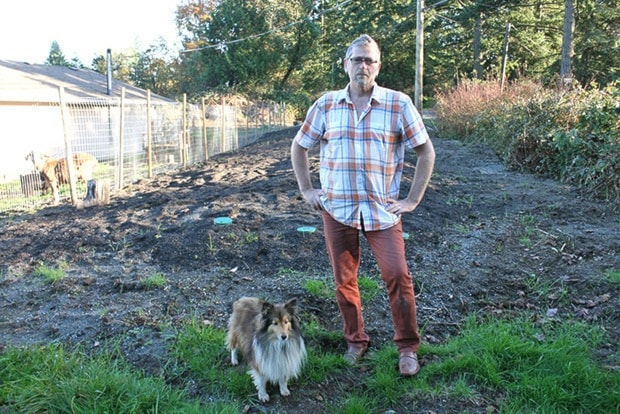Property owners on Old West Saanich Road believe Saanich is hiding behind an archaic law after a burst water main flooded their septic field.
Back in June, Jeff and Pat Hoogendorn noticed their property’s septic field, which abuts West Saanich Road, was saturated and draining downhill to the neighbour’s property.
They called on one professional and then another, both who performed work but were unable to solve the problem. A third septic company, Kelly Karr’s Canadian Sewage Systems, came in September and noticed things weren’t adding up.
Fifteen thousand dollars later, the Hoogendorns are in disbelief that Saanich is refuting their claim for reparation.
“If we caused $15,000 damage to Saanich property do you think we could get away with it?” asked Jeff Hoogendorn.
The Hoogdendorns said the law Saanich is standing by is based on an 1868 precedent that’s been modified as rule 288 in the B.C. Local Government Act. Essentially, the law immunizes Saanich.
Because the claim has reached Saanich’s risk management level, staff are unable to comment on it. Saanich director of engineering Harley Machielse did confirm the broken water main, however.
Rule 288, which provides immunity against certain nuisance actions in the B.C. Local Government Act, is based on Rylands vs. Fletcher, an 1860s ruling from Britain where the owner of a burst water reservoir wasn’t found guilty despite the reservoir flooding and damaging a neighbouring mine.
The reasons are debatable, and the law has been thrown out in Scotland and Australia. Despite giving consideration to scrapping the law, it is still on the books in England. In B.C., the law has been adjusted to protect municipalities.
Karr, an engineer, said there’s no question the burst water main led to the demise of the septic field.
“We traced the water back to an unusual source coming onto the property at a high volume, sometimes this can be a river of groundwater, and without checking you can’t know why,” said Karr, “but it suggests a water leak. It was a particularly dry summer.”
Without making any headway, Karr’s team pumped green dye into the septic field system. The dye-coloured water surfaced just as the septic waste had been all summer, except for one area near West Saanich Road.
“One clear patch was unusual, why wasn’t it dyed?” Karr said. “So, we investigated with a curtain drain and saw it was coming from the road.”
Karr notified Saanich there was probably a water leak.
Saanich visited the abutting site for assessment on Sept. 24, and on Sept. 25 they repaired a broken half-inch copper pipe providing water service to the neighbouring property at 4890 West Saanich Rd., which is next to the Hoogendoorn septic field.
Once the pipe was fixed, the water stopped, Karr said. His company let the septic field dry out for the weekend so it could complete the job of removing bad soil, replacing and adding some septic pipes, and adding new soil.
“Absolutely, 100 per cent if the water line didn’t break it wouldn’t have had that problem,” Karr added.
Pat Hoogendorn’s concern is that Saanich does not have to prove it wasn’t at fault. As a taxpayer, she’s wondering where the protection is.
“Why is this legislation still around? It’s impacting taxpayers, it needs to be revisited,” she said. “I want Saanich to take responsibility, not to use 288. This is not solely about our situation, but having Saanich take a hard look at the impact on others it affects referencing section 288.”
